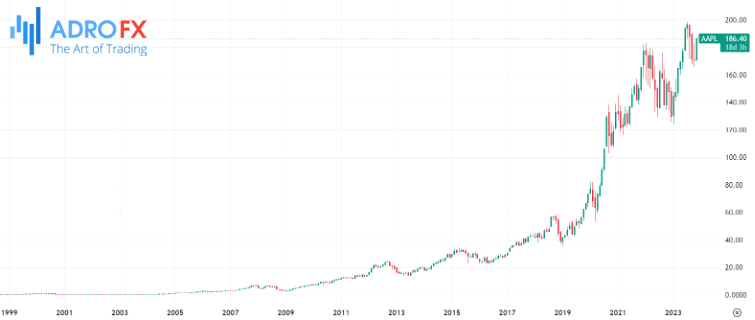Trading Apple Stock: Business Segments, Stock Analysis, and Investment Strategies

Apple Inc. stands as a unique entity in the corporate world, celebrated for its organizational simplicity and a product and service portfolio that requires no introduction. Unlike its industry peers like Microsoft, Alphabet, and Berkshire Hathaway, Apple refrains from large-scale acquisitions, maintaining a clear and unmistakable brand identity. This article delves into the distinct segments that compose Apple's operations, its stock performance, market dynamics, and investment strategies for both long-term investors and day traders.
Apple Business Segments
One distinguishing feature of Apple is its organizational simplicity, setting it apart from larger companies like Microsoft, Alphabet, and Berkshire Hathaway. Unlike these competitors, Apple refrains from acquiring major corporations, resulting in a clear and well-known product and service portfolio.
Apple operates within four key segments: iPhone, Mac, iPad, Wearables and Accessories, and Services. The iPhone stands as the primary revenue generator for the company, amassing over $206 billion in sales during 2022. It is followed by Services, which contributed $78 billion to the company's revenue. The Mac segment generated $40 billion, with the iPad and Wearables segments contributing $29 billion and $41 billion, respectively.
In recent years, Apple has expanded its services offerings, recognizing their critical role in the company's future. These services encompass essential offerings such as Apple Music, Apple TV, Apple Care, Apple Pay, and iCloud, among others.
Apple Stock Symbol, Market Cap, Revenue, and Profits
Apple's stock is identified by the ticker symbol AAPL, and the company boasts a market capitalization exceeding $2.1 trillion. The market cap figure is dynamic, closely linked to the share price, and continually fluctuates. Notably, Apple stands as a highly financially successful company, evident in the figures displayed in the chart below.

Apple has consistently experienced revenue growth over the years, surging from over $170 billion in 2013 to a remarkable $394 billion in 2022. Similarly, its net profit witnessed a significant increase, soaring from $37 billion to $99 billion within the same period.
Apple Market Share
Apple's growth trajectory is attributed to the premium quality of its products and its substantial market share. For instance, the iPhone commands a sizable market share of approximately 24%, a significant portion considering the multitude of competitors in the smartphone industry.

In the computing industry, Apple maintains a substantial market share despite competing with Microsoft-based products, consistently selling hundreds of computers annually, positioning itself as a prominent industry player.
Furthermore, Apple ranks as the world's second-largest music streaming service, trailing only Spotify. Additionally, it operates the most successful app store globally. While Android holds the largest market share, Apple's app store is the most lucrative.
Investing or Trading Apple Stock
A common question arises regarding whether Apple represents a worthwhile investment or trading asset. There are compelling reasons to consider investing in Apple.
For one, the company's historical performance is impressive, with shares having surged by more than 45,000% since 2000. While past performance is not a guarantee of future outcomes, it can provide valuable insights.

Other factors supporting investment in Apple include its straightforward business model, a loyal customer base, and aspirational products. The iPhone, in particular, remains a highly sought-after device. Additionally, Apple is renowned for its consistent lucrativeness and market share growth. Analysts anticipate continued business expansion in the coming years.
However, we also suggest considering day trading of Apple shares for several reasons:
- High Liquidity: Apple is a highly liquid stock, with millions of shares traded daily, facilitating easy buying and selling.
- Volatility: Apple's stock is notably volatile, offering intriguing entry and exit points for traders.
- Media Attention: Apple garners extensive media coverage in the financial industry, presenting numerous trading opportunities.
- Accessibility: Apple shares are available through numerous online brokers, making them easily accessible.
As a result, we recommend including Apple in both a long-term investment portfolio and a trading account, capitalizing on the benefits of its liquidity, volatility, media coverage, and accessibility.
Valid Reasons to Avoid Investing in Apple
First, it's worth noting that Apple's stock may currently be trading at a premium when you look at its price-to-earnings ratio, commonly referred to as the P/E ratio. The P/E ratio for Apple stands at 31 (as of November, 2023), which is relatively high. This suggests that investors are willing to pay a bit more for each dollar of earnings generated by the company's stock. In other words, the stock could be seen as overvalued compared to its earnings.
Another aspect to consider is dividend yield, which is important for investors seeking income from their investments. In the case of Apple, its dividend yield is relatively modest at 0.52%. This means that, as a shareholder, you would receive a dividend payout equivalent to 0.52% of your investment. While Apple's stock has its strengths, those who prioritize higher dividend income might find more appealing options in other stocks.

Analyzing Apple Stock
When considering an investment in Apple, your approach should align with your investment horizon. For those with a long-term investment perspective, several crucial aspects deserve your attention:
● Revenue and Profitability Growth: Take a close look at Apple's historical performance in terms of revenue and profitability. Over the years, Apple has demonstrated consistent growth in these key metrics, underlining its financial strength and stability.
● Segment Growth: Evaluate the growth trajectory of Apple's individual business segments. Of particular importance is the services segment, which has become a pivotal driver of the company's success. Analyze how this segment is evolving and contributing to the overall business.
● New Product Launches: Stay well-informed about Apple's product launches. New products can significantly impact the company's profitability and market position. Keep an eye on the reception and success of these launches as they can be indicative of future prospects.
● Dividend Metrics: If you are interested in dividend income, assess Apple's performance in terms of dividend growth, safety, yield, and the consistency of dividend payouts. A reliable dividend track record can be appealing to long-term income-focused investors.
● Estimates: Monitor the revenue and profitability estimates provided by analysts for future periods. Analyst consensus can offer insights into market expectations and provide guidance for your long-term investment strategy.
On the other hand, for day traders who operate with a shorter investment horizon, a different set of considerations comes into play:
● Technical Analysis: Place your primary focus on technical analysis, which involves examining chart patterns and utilizing technical indicators to make short-term trading decisions. Short-term charts are your primary tools for identifying potential trading opportunities.
By tailoring your approach to your investment horizon, you can make well-informed decisions regarding your engagement with Apple's stock, whether you are looking for stable long-term growth or short-term trading opportunities.
SWOT Analysis for Apple Stock
Taking a holistic look at Apple's stock through a SWOT analysis reveals various facets:
Strengths
Apple's financial stability and substantial resources underscore its strong balance sheet. The brand's unwavering commitment to quality, design, and user experience has fostered a deeply loyal customer base. The company's expanding market share across different product segments adds to its strengths. Moreover, Apple's global brand recognition and reputation are unparalleled.
Weaknesses
A notable challenge is Apple's heavy reliance on iPhone sales for a substantial portion of its revenue. This overdependence on a single product category is a potential weakness. Additionally, for investors seeking substantial dividend income, Apple's stock may be less appealing due to its relatively low dividend yield.
Opportunities
Apple has the potential for further global market share expansion, particularly in emerging markets. Untapped regions offer opportunities for growth.
Threats
Apple's exposure to US-China trade tensions is a prominent threat, with potential impacts on operations and the supply chain. A strong US dollar affecting global affordability can influence international sales and profitability. Evolving regulatory concerns, particularly in the context of the App Store, pose risks to business practices and profitability. The competitive landscape in streaming services, especially when competing with established players like Netflix, presents challenges and could affect the success of its services segment.
This comprehensive SWOT analysis equips investors with valuable insights to make informed decisions regarding Apple's stock.
Day Trading Strategies for Apple Stock
Consider these strategies for day trading Apple shares:
- Trend Following
Buy Apple shares when they are on an upward trend and hold the position until the trend weakens. - Reversal Trading
Wait for a trend to weaken, and then trade the reversal. Use technical indicators like moving averages and the Relative Strength Index (RSI) or chart patterns like double tops and head and shoulders for guidance. - Candlestick Patterns
Utilize candlestick patterns such as doji, hammer, and shooting star to identify breakout and reversal opportunities. - Scalping
Open positions and quickly exit them to capture small returns. This strategy aims to capitalize on short-term price movements.
Conclusion
Apple's journey through the corporate landscape, with its diverse business segments, remarkable stock performance, and expanding market share, presents a compelling case for investment. Its historical strength, straightforward business model, loyal customer base, and aspirational products reinforce the company's potential for growth. Analysts foresee continued expansion on the horizon. However, day trading Apple shares also offers a lucrative opportunity due to its high liquidity, volatility, extensive media coverage, and accessibility through various online brokers. Whether as a long-term investment or a trading asset, Apple's presence in portfolios remains a strategic choice.

About AdroFx
Established in 2018, AdroFx is known for its high technology and its ability to deliver high-quality brokerage services in more than 200 countries around the world. AdroFx makes every effort to keep its customers satisfied and to meet all the trading needs of any trader. With the five types of trading accounts, we have all it takes to fit any traders` needs and styles. The company provides access to 115+ trading instruments, including currencies, metals, stocks, and cryptocurrencies, which make it possible to make the most out of trading on the financial markets. Considering all the above, AdroFx is the perfect variant for anyone who doesn't settle for less than the best.








